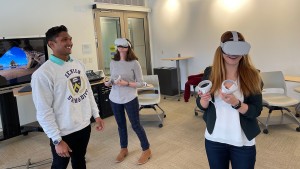Students in ARHS 232: “Early Medieval Art” are now able to “visit” medieval churches without leaving Gambier, as Professor of Art History Sarah Blick has started to incorporate virtual reality (VR) into the classroom.
The process to get to the point of “visiting” far-off places like Aachen Cathedral in Germany took about two years. Blick has been working with Digital Initiatives Librarian Jenna Nolt and Cherantha De Silva ’23 to make VR in classrooms an actual reality. The trio received a grant from the Hewlett Foundation in 2021 with Adjunct Assistant Professor of Art History and Visual Resources Curator Yan Zhou and Henry Allan ’23 to attend the Ohio Five CODEX (Collaborative for Digital Engagement and Experience) Summer Institute, a five-day program where students, faculty and staff come together to learn how to use technology in classrooms.
Last summer, De Silva, an economics major, tested out ways in which technology could be used to enhance students’ learning in Chalmers Library. He settled on using the VR headsets, and worked on getting the technology setup. “The main goal for this project was to get a virtual reality headset, where we can use this in class,” De Silva said. He now has produced a document detailing the setup, which can be done in two minutes.
To help work out the kinks with the headset, De Silva asked students studying in Chalmers if they wanted to test the new technology, and he ran a survey recording their experience with VR. De Silva said that many students were very excited to try it out, and that although VR headsets can sometimes give users a feeling of motion sickness, students did not seem to have an issue.
The two-year process has been collaborative. “We’ve tried to do it in this non-hierarchical model of faculty, staff, students working together — that is at the core of the kind of work that we’ve been doing here,” said Nolt. “The goal is we want to create something out of this that is enriching the education of our students.” De Silva enjoys the collaboration and describes the relationships as “incredible,” praising both Nolt and Blick as “optimistic and supportive.” Blick is grateful to Kenyon for providing funding and noted that “the continuity really lies with the staff and the faculty, but really, the students bring the energy and frankly, sometimes the vision.”
Now that the technology is available to use in class, the team’s goal is to be able to expand access to technology to make it truly interdisciplinary. “One of the things that we want to have come out of this is implementing this in classrooms across the College in different ways,” Nolt said. “I would love to see a track or a couple of classes in every discipline at Kenyon where students are engaging with the pedagogical materials in a virtual environment, and I think that the medium creates a capacity to engage with materials in ways that we haven’t before.”
Blick recalls a time when even showing a video in a classroom was a challenge. “I’m old enough to remember where you still needed to bring in a film projector, you had to thread the film through, you had to have different kinds of skills and setups,” she said. “Whereas now it’s like, it’s nothing, and I kind of hope that [VR] will become nothing: that it just becomes another tool of understanding and hopefully, some creativity.”
De Silva, who is also a member of Kenyon’s swimming and diving team, hopes to be able to change the way students learn at Kenyon. “I literally want to revolutionize the traditional classroom in Kenyon College, because I feel like in the 1980s we were using chalkboards and whiteboards, but now we’re using projectors and laptops,” he said. “The next phase of technological improvements in the education setting is using virtual reality.”
For now, Kenyon students are using VR headsets to look at buildings. Ultimately, Blick hopes to be able to take a whole class on a “field trip” while staying in Gambier. “I don’t think we quite have the technology; we’re getting there,” she said. “What I’d want to do is just bring the students into a room, so that they feel as if they stepped into the church itself.”
